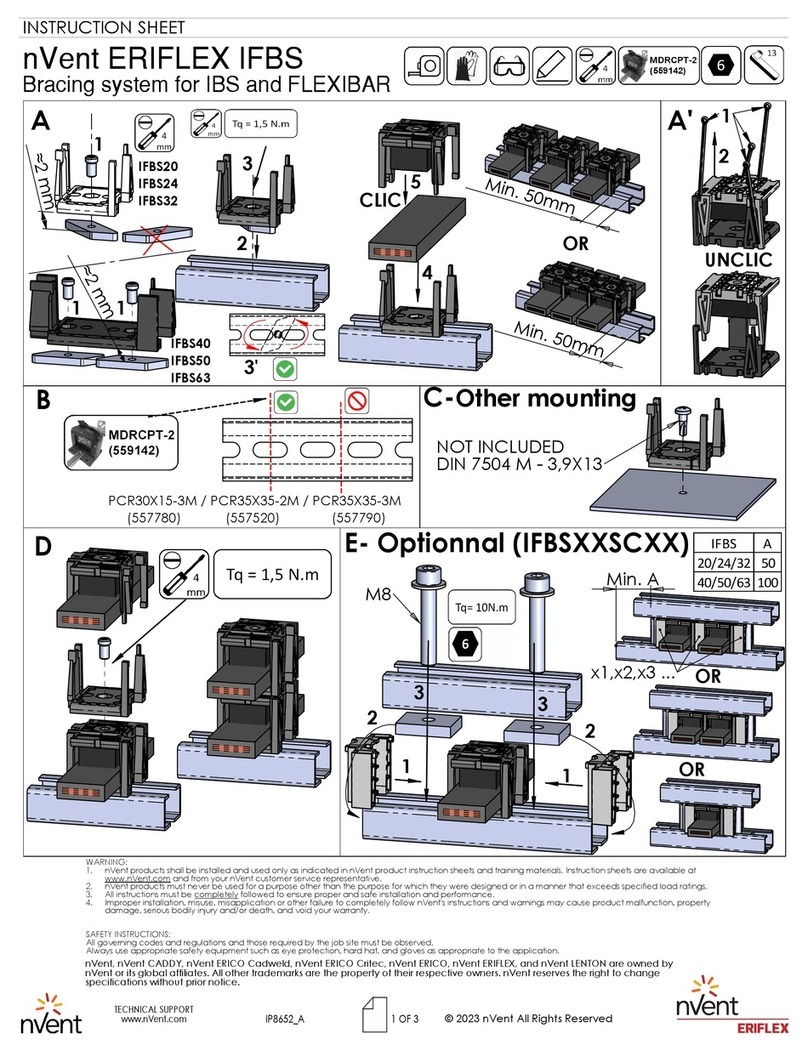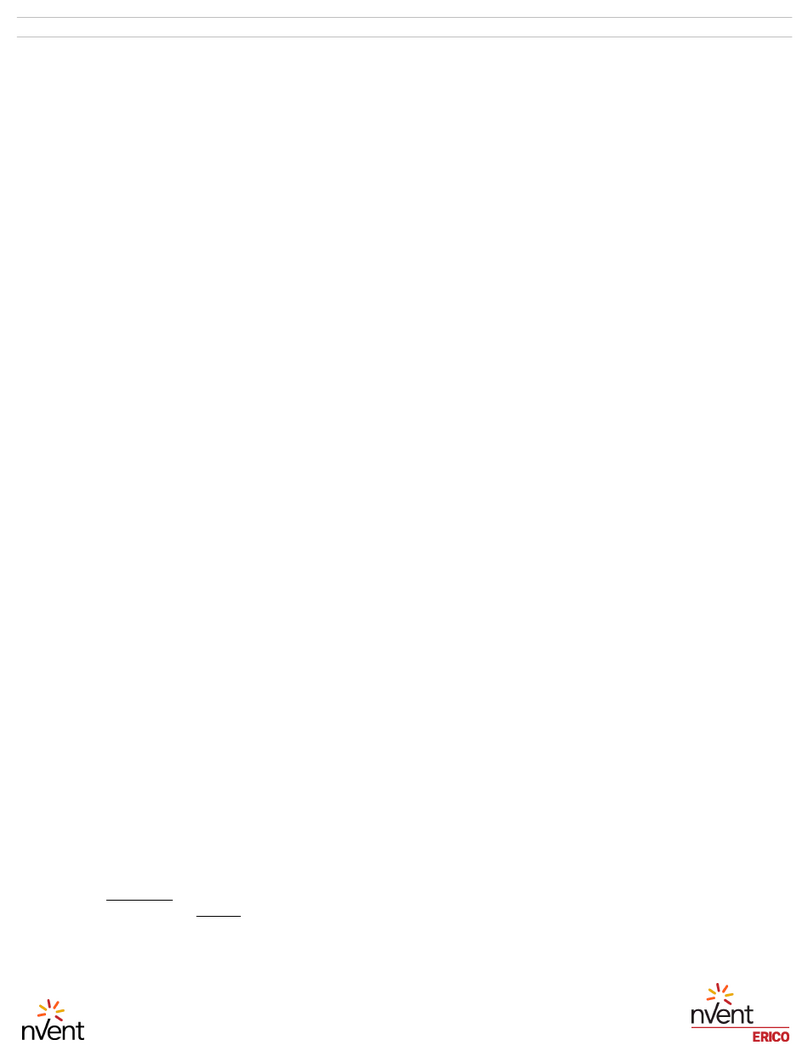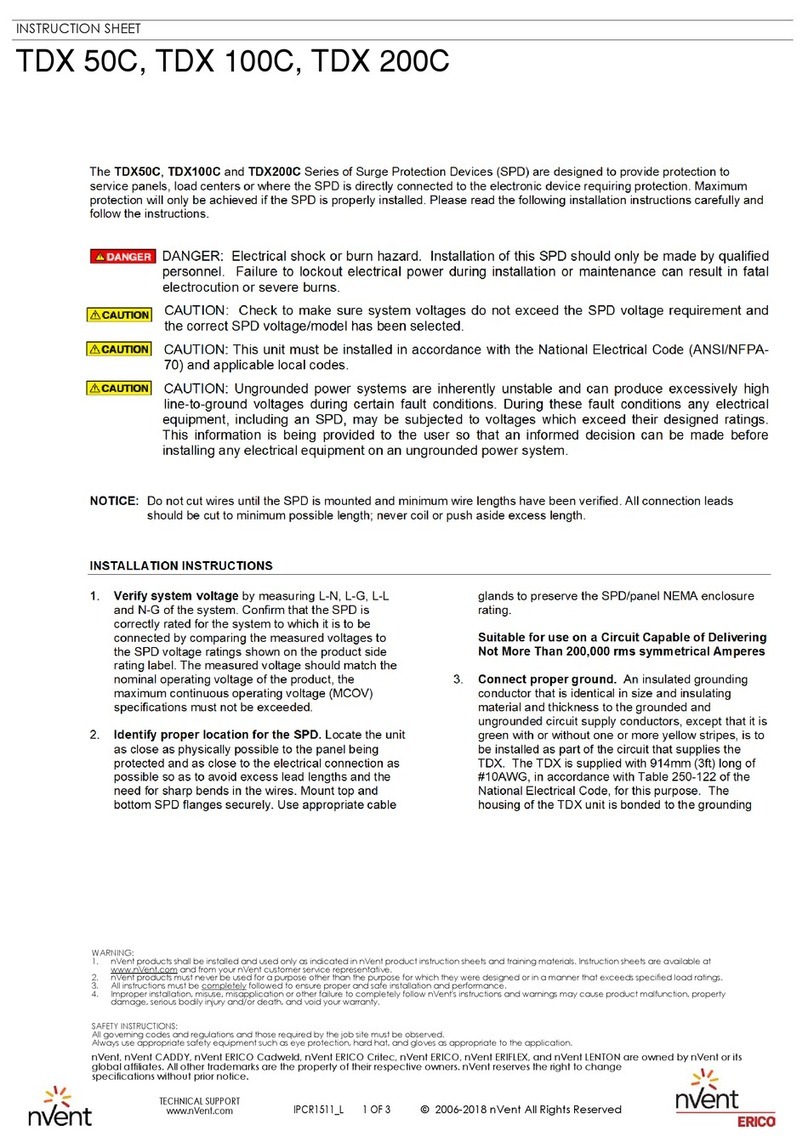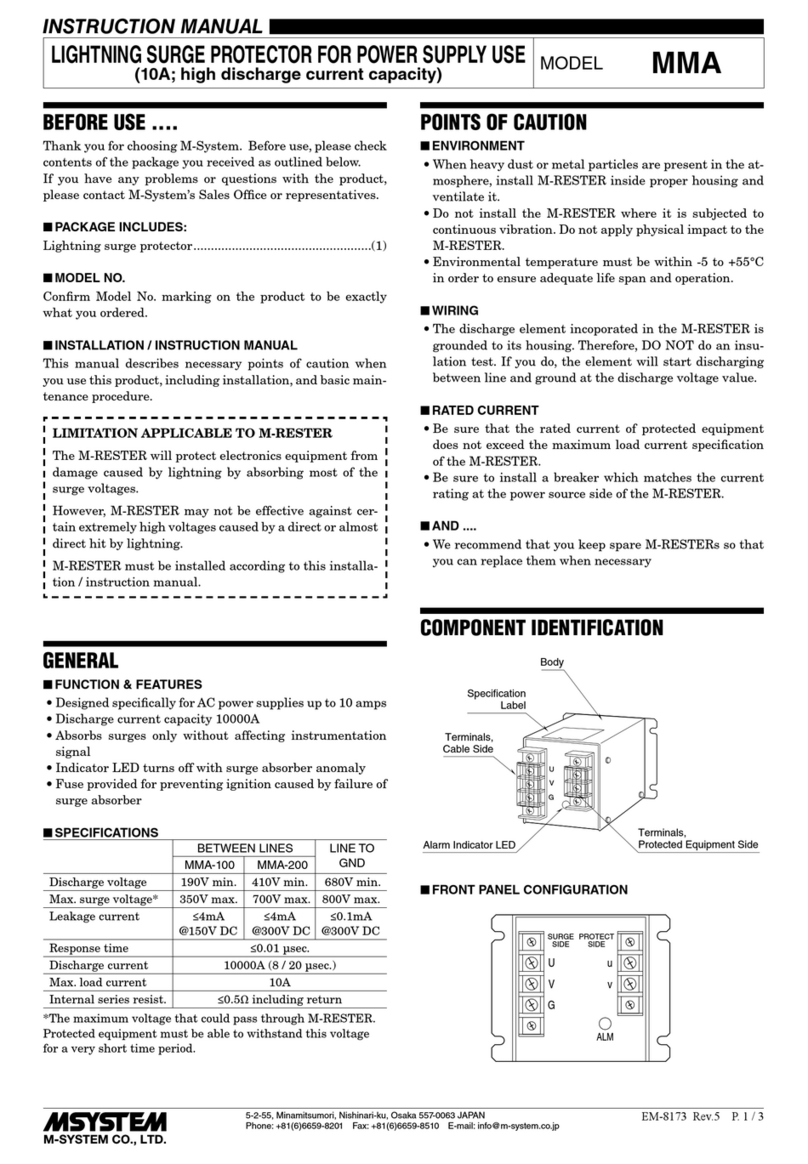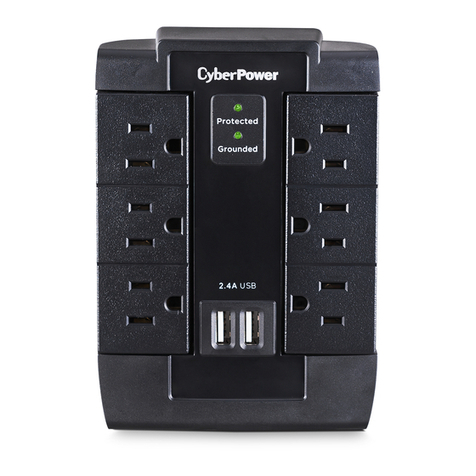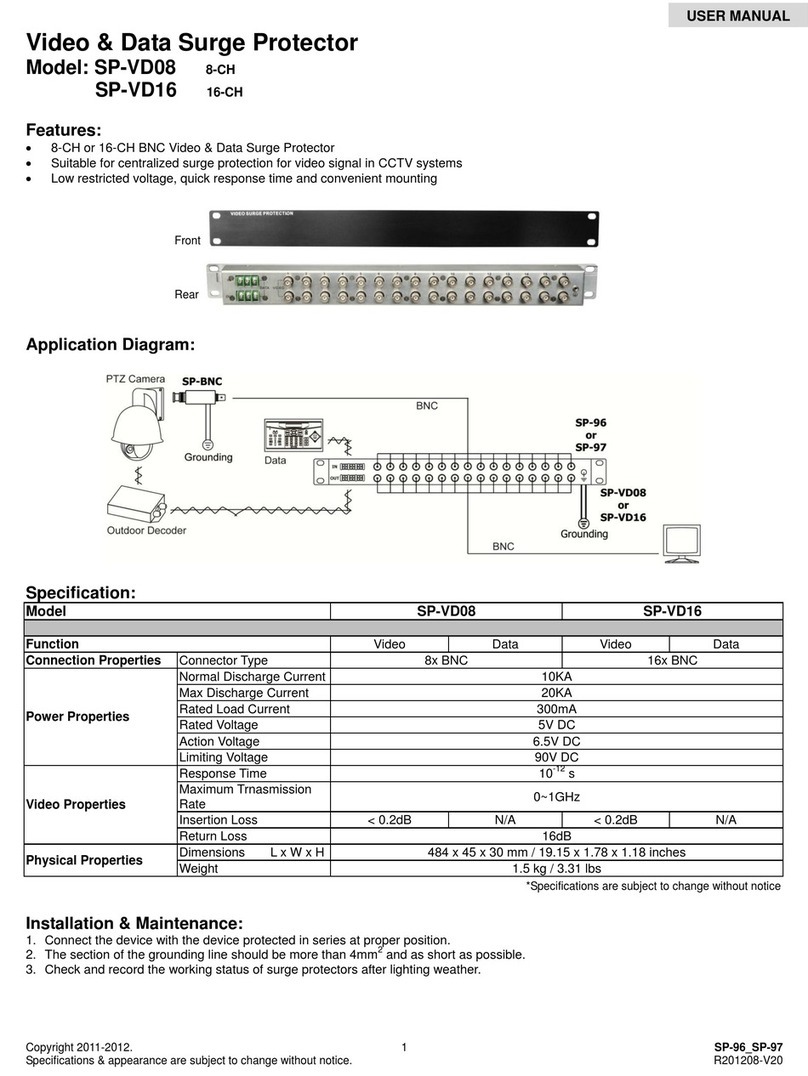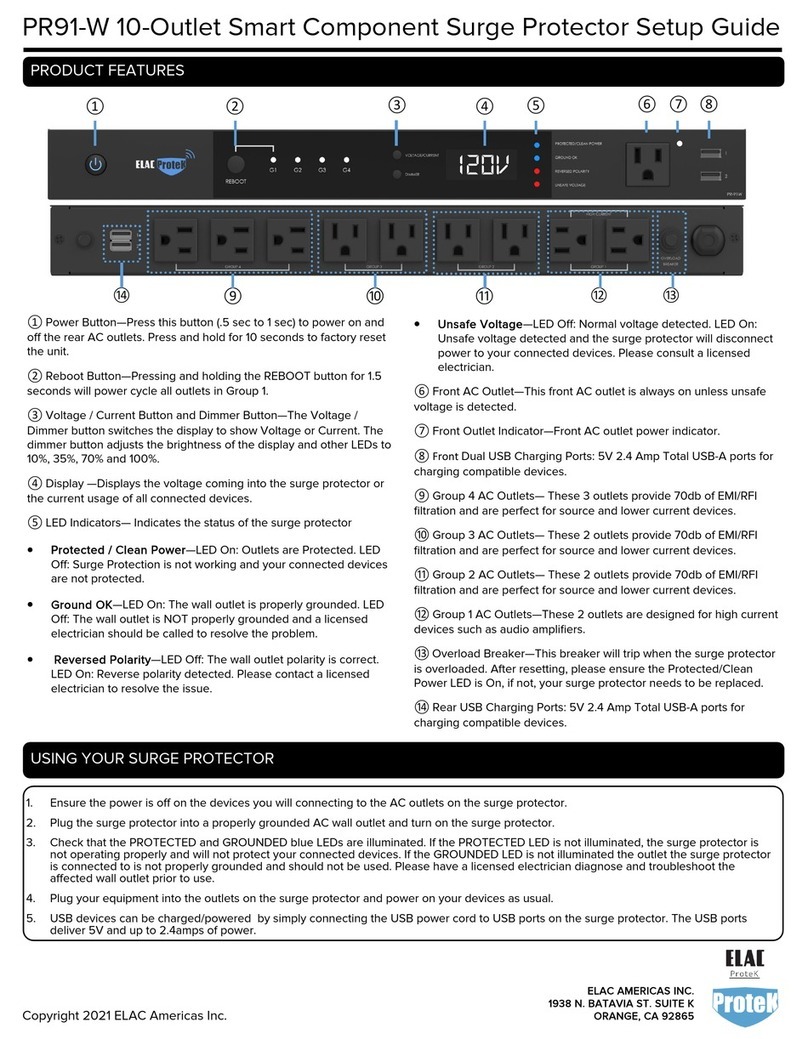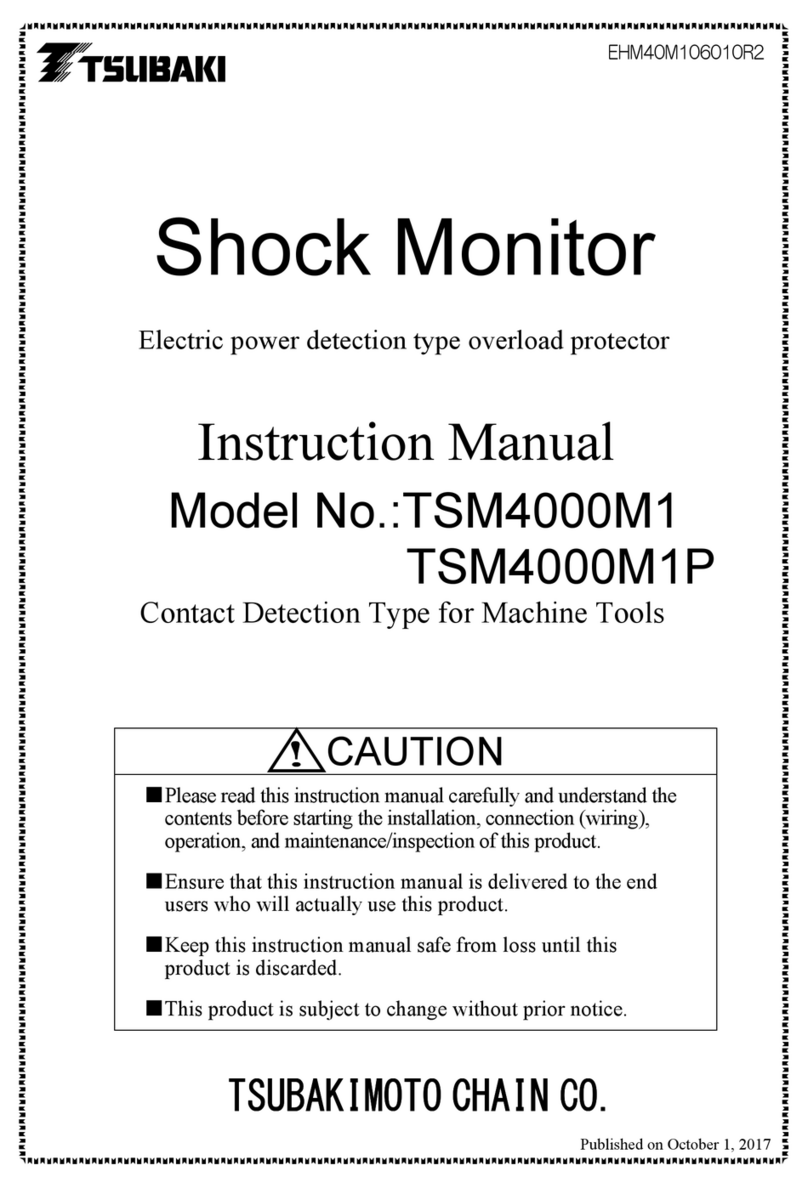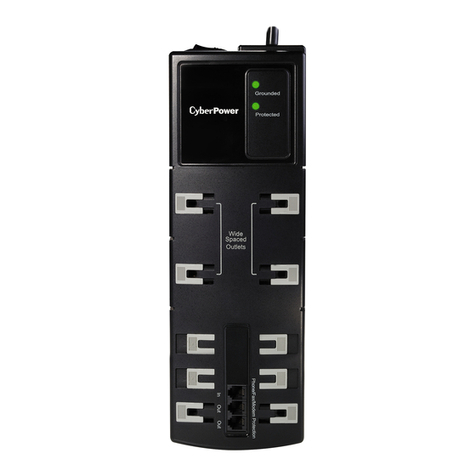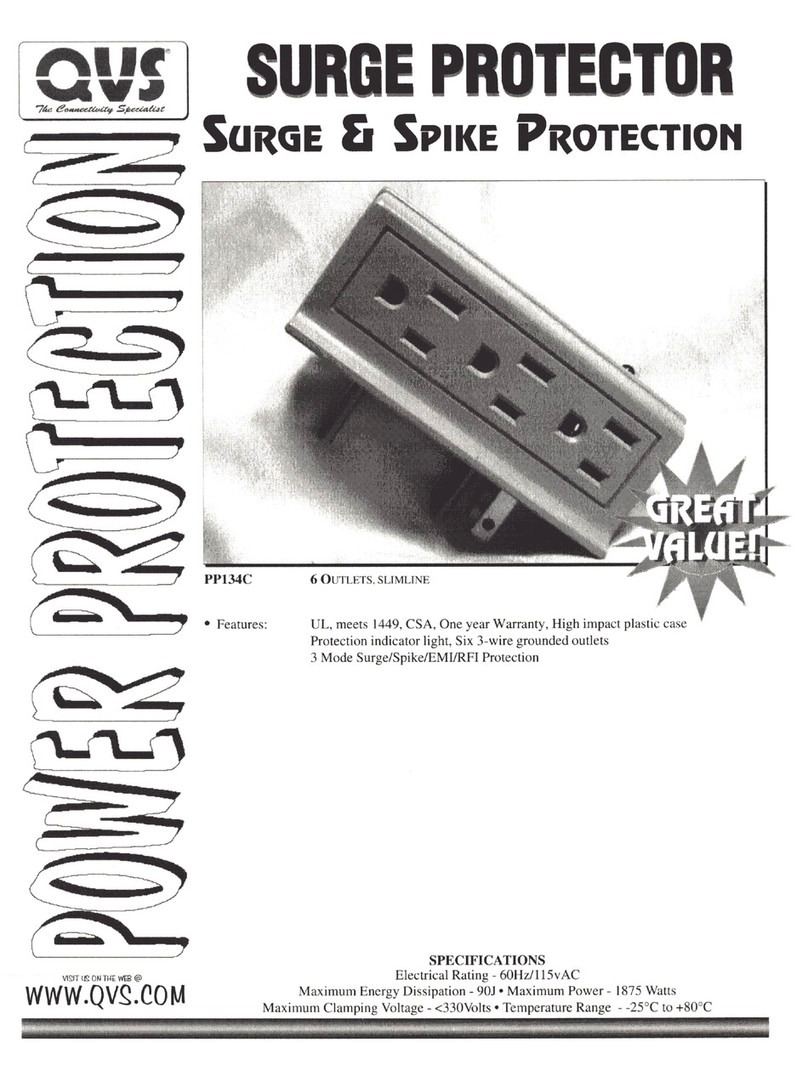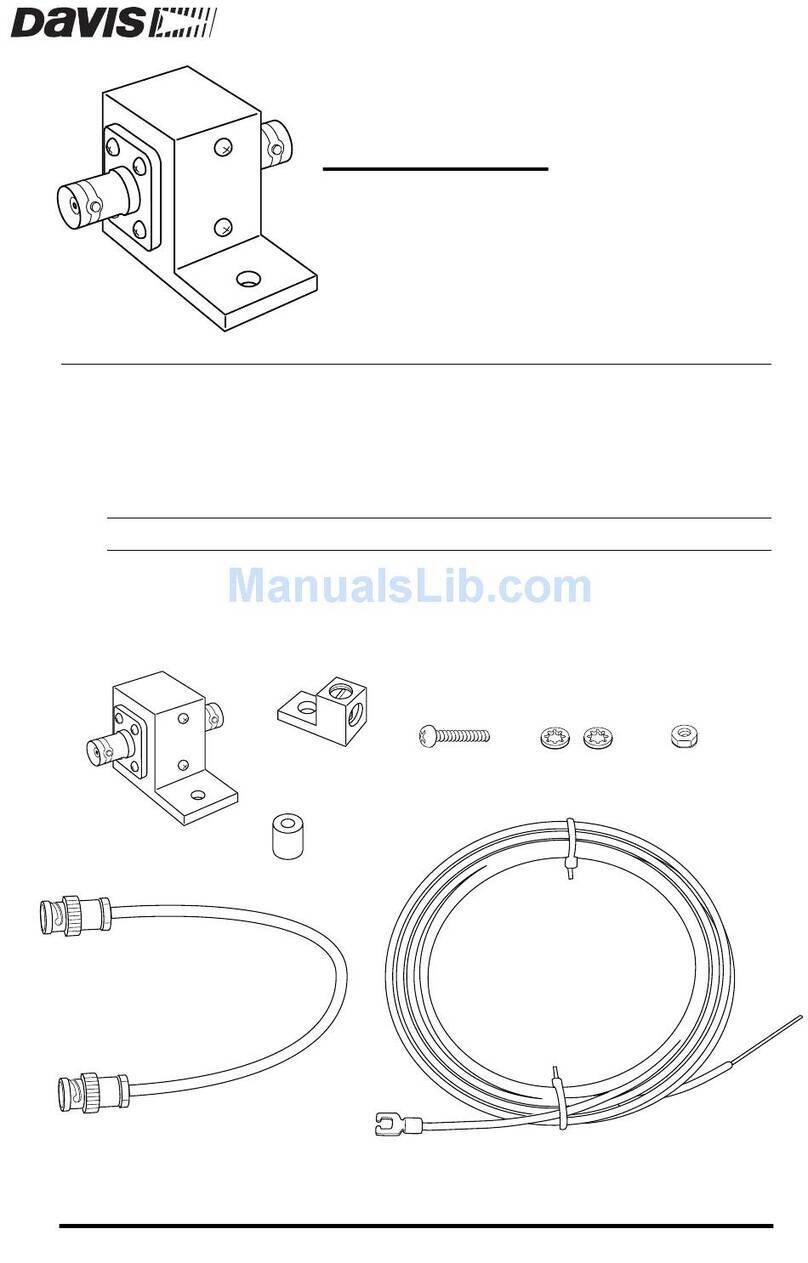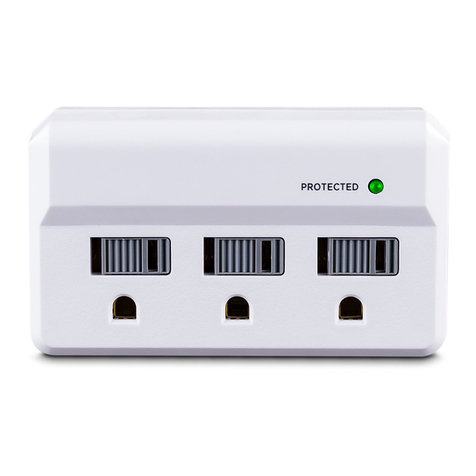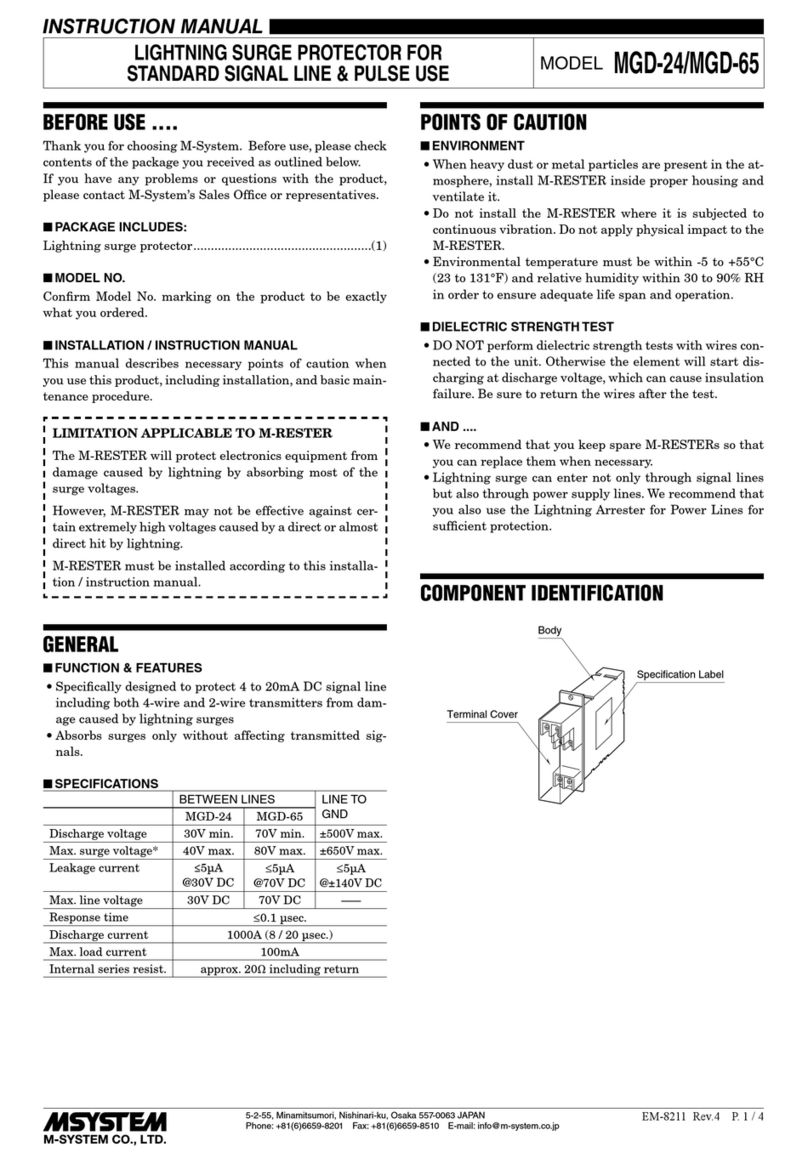nvent SES160 B Series User manual

IP9000 1 OF 5
INSTRUCTION SHEET
SES160 B Series
Surge Protective Device
© 2021-2022 nVent All Rights Reserved
TECHNICAL SUPPORT
www.nVent.com
nVent, nVent CADDY, nVent ERICO Cadweld, nVent ERICO Critec, nVent ERICO, nVent ERIFLEX, and nVent LENTON are owned by nVent or its
global affiliates. All other trademarks are the property of their respective owners. nVent reserves the right to change
specifications without prior notice.
WARNING:
nVent products shall be installed and used only as indicated in nVent product instruction sheets and training materials. Instruction sheets are available at 1.
www.nVent.com and from your nVent customer service representative.
nVent products must never be used for a purpose other than the purpose for which they were designed or in a manner that exceeds specified load ratings.2.
All instructions must be completely followed to ensure proper and safe installation and performance. 3.
Improper installation, misuse, misapplication or other failure to completely follow nVent's instructions and warnings may cause product malfunction, property 4.
damage, serious bodily injury and/or death, and void your warranty.
SAFETY INSTRUCTIONS:
All governing codes and regulations and those required by the job site must be observed.
Always use appropriate safety equipment such as eye protection, hard hat, and gloves as appropriate to the application.
WARNINGS
• Safety First – Hazardous Voltage & Shock Hazard
• Only qualified licensed electricians should install or service SPDs
• Hazardous voltages exist within SPDs
• SPDs should never be installed or serviced when energized
• Use appropriate safety precautions including Personal Protection Equipment
• Failure to follow these instructions can result in death, serious injury, and/or equipment damage
• This manual shall be read in its entirety prior to installing
Bonding and Grounding Hazard
Verify that the neutral conductor in the service entrance equipment is bonded to ground in accordance
with the National Electric Code (NEC®) and all applicable codes. During installation into an electrical
system the panel must not be energized; or the Circuit Breaker de-energized, until the SPD
is completely
installed, inspected and tested. All conductors must be connected and functional including the neutral
(if required).
The voltage rating of the SPD and system must be verified before energizing the SPD. Failure to
follow these guidelines can lead to abnormally high voltages at the SPD. This may cause the SPD
to fail. The warranty is voided if the SPD is incorrectly installed and/or if the neutral conductor in the
service entrance equipment or downstream of separately derived systems is not bonded to ground in
accordance with the NEC®
Do Not Hi-Pot Test SPDs
Any factory or on-site testing of power distribution equipment that exceeds normal operating voltage
such as high-potential insulation testing, or any other tests where the suppression components will be
subjected to higher voltage than their rated Maximum Continuous Operating Voltage (MCOV) must
be conducted with the SPD disconnected from the power source. For 4-wire systems, the neutral
connection at the SPD must also be disconnected prior to performing high-potential testing. Failure to
disconnect SPD and associated components during elevated voltage testing
will damage the SPD and will
void the warranty.
SPDs on Ungrounded Systems
Caution – Ungrounded systems are inherently unstable and can produce excessively high line-to ground
voltages during certain fault conditions. During these fault conditions, any electrical equipment
including an SPD may be subjected to voltages which exceed their designed ratings. An SPD designed
specifically for Ungrounded systems should be used.

IP9000 2 OF 5
INSTRUCTION SHEET
SES160 B Series
Surge Protective Device
© 2021-2024 nVent All Rights Reserved
TECHNICAL SUPPORT
www.nVent.com
nVent, nVent CADDY, nVent ERICO Cadweld, nVent ERICO Critec, nVent ERICO, nVent ERIFLEX, and nVent LENTON are owned by nVent or its
global affiliates. All other trademarks are the property of their respective owners. nVent reserves the right to change
specifications without prior notice.
WARNING:
nVent products shall be installed and used only as indicated in nVent product instruction sheets and training materials. Instruction sheets are available at 1.
www.nVent.com and from your nVent customer service representative.
nVent products must never be used for a purpose other than the purpose for which they were designed or in a manner that exceeds specified load ratings.2.
All instructions must be completely followed to ensure proper and safe installation and performance. 3.
Improper installation, misuse, misapplication or other failure to completely follow nVent's instructions and warnings may cause product malfunction, property 4.
damage, serious bodily injury and/or death, and void your warranty.
SAFETY INSTRUCTIONS:
All governing codes and regulations and those required by the job site must be observed.
Always use appropriate safety equipment such as eye protection, hard hat, and gloves as appropriate to the application.
Unpacking & Preliminary Inspection
Inspect the entire shipping container for damage or signs of mishandling. Remove the packing materials
and further inspect the unit for any obvious shipping damages. If any damage was found and is a result
of shipping or handling, immediately file a claim with the shipping company and forward a copy to
nVent.
Storage Environment
This SPD should be stored in a clean, dry environment. Storage temperature range is -40°C (-40°F) to
+60°C (+140°F). Avoid exposure to high condensation.
PRE-INSTALLATION & INSTALLATION PLANNING
Operating Environment
The standard unit uses a NEMA 4X enclosure. Flush-mount kits are available as option. Before installing,
ensure that your enclosure type and application are appropriate with regard to moisture, dirt, excessive
dust, flammable materials or atmospheres, corrosive vapors, etc. This SPD is designed in an ambient
temperature range of -25°C (-13°F) to +85°C (+185°F) with a relative humidity of 0% to 95%
(noncondensing). Excessive temperature may inadvertently operate internal thermal over temperature
protectors.
Line Side versus Load Side Installation
The SES160 B Series is tested and Listed as a Type 1 SPD per UL 1449 4th Ed. This SPD can be installed
on
the Line Side of the service overcurrent device. Type 1 SPDs may also be installed in UL Type 2
Applications. In general, it is more practical to install as Type 2 on the load side of the main overcurrent
Device for maintenance reasons.
Audible Noise
SPD background noise is negligible or non-existent, and does not restrict the location of installation.
Lead Lengths & Maximizing SPD Performance
SPDs must be located as close to the circuit as possible to minimize let-through voltage
. Use the shortest
& straightest possible leads. Pre-Plan installations and ensure that nearest breaker positions are used. If
new construction, adjust breaker locations as appropriate. When longer leads are unavoidable, gently
twist leads together (one to two twists per foot), or tie-wrap leads together.

IP9000 3 OF 5
INSTRUCTION SHEET
SES160 B Series
Surge Protective Device
© 2021-2024 nVent All Rights Reserved
TECHNICAL SUPPORT
www.nVent.com
nVent, nVent CADDY, nVent ERICO Cadweld, nVent ERICO Critec, nVent ERICO, nVent ERIFLEX, and nVent LENTON are owned by nVent or its
global affiliates. All other trademarks are the property of their respective owners. nVent reserves the right to change
specifications without prior notice.
WARNING:
nVent products shall be installed and used only as indicated in nVent product instruction sheets and training materials. Instruction sheets are available at 1.
www.nVent.com and from your nVent customer service representative.
nVent products must never be used for a purpose other than the purpose for which they were designed or in a manner that exceeds specified load ratings.2.
All instructions must be completely followed to ensure proper and safe installation and performance. 3.
Improper installation, misuse, misapplication or other failure to completely follow nVent's instructions and warnings may cause product malfunction, property 4.
damage, serious bodily injury and/or death, and void your warranty.
SAFETY INSTRUCTIONS:
All governing codes and regulations and those required by the job site must be observed.
Always use appropriate safety equipment such as eye protection, hard hat, and gloves as appropriate to the application.
Voltage Rating
Before installing SPD, verify that it has the same voltage rating as the power distribution system.
Compare the SPDs nameplate voltage or model number and ensure that SPD configuration matches the
intended power source.
Circuit Breaker Connected
When connected on load side of main disconnect, we suggest connecting via a 30A circuit breaker.
Ensure that the circuit breaker can accommodate the number for phases the SPD is designed for. The
circuit breaker is the intended disconnect switch and provides short circuit protection to the connecting
conductors. These SPDs have internal overload protection elements within the product. These SPDs
have demonstrated 200kA Short Circuit Current Ratings (SCCRs).
System Grounding
An equipment grounding conductor must be used on all electrical circuits connected to the SPD. For the
best performance, use a single point ground system where the service entrance grounding electrode
system is connected to and bonded to all other available electrodes, building steel, metal water pipes,
driven rods, etc. (for reference see: IEEE Std 142-2007). For sensitive electronics and computer systems,
we recommend that the ground impedance measurement be as low as possible.
When metallic raceway is used as an additional grounding conductor, an insulated grounding conductor
should be run inside the raceway and sized per the NEC®. Adequate electrical continuity must be
maintained at all raceway connections. Do not use isolating bushings to interrupt a metallic raceway
run. A separate isolated ground for the SPD is NOT recommended. Proper equipment connections to
grounding system and ground grid continuity should be verified via inspections and testing on a regular
basis as part of a comprehensive electrical maintenance program. On 4-Wire Power System Service
Entrance Panels, neutral to ground bonding (Main Bonding Jumper) must be installed per the NEC®.
Failure to do so WILL damage SPDs.
CAUTION: This unit must be installed in conformance with all governing codes and instructions, and must be installed on the
load side of the main over-current protection.
Retro-fit Into Existing Panel with No Available Breaker Positions
Follow all applicable Codes:
Consider consolidating loads in a manner that might free breaker positions.
A ten foot tap rule in NEC® 240.21(B)(1) allows you to tap the bus as long as the tap conductors are
rated at least 10% of the ampacity of the panel. In the case where the ampacity of the panel is larger
than the wires of the SPD, consider tapping the bus per NEC® 240.21(B)(1) and running appropriate size
conductors to a safety switch fused to 30A. Mount the SPD immediately adjacent to the safety switch.

IP9000 4 OF 5
INSTRUCTION SHEET
SES160 B Series
Surge Protective Device
© 2021-2024 nVent All Rights Reserved
TECHNICAL SUPPORT
www.nVent.com
nVent, nVent CADDY, nVent ERICO Cadweld, nVent ERICO Critec, nVent ERICO, nVent ERIFLEX, and nVent LENTON are owned by nVent or its
global affiliates. All other trademarks are the property of their respective owners. nVent reserves the right to change
specifications without prior notice.
WARNING:
nVent products shall be installed and used only as indicated in nVent product instruction sheets and training materials. Instruction sheets are available at 1.
www.nVent.com and from your nVent customer service representative.
nVent products must never be used for a purpose other than the purpose for which they were designed or in a manner that exceeds specified load ratings.2.
All instructions must be completely followed to ensure proper and safe installation and performance. 3.
Improper installation, misuse, misapplication or other failure to completely follow nVent's instructions and warnings may cause product malfunction, property 4.
damage, serious bodily injury and/or death, and void your warranty.
SAFETY INSTRUCTIONS:
All governing codes and regulations and those required by the job site must be observed.
Always use appropriate safety equipment such as eye protection, hard hat, and gloves as appropriate to the application.
INSTALLATION
Pre-Plan your installation
• Meet all National and Local codes. (NEC® Article 242 addresses SPDs)
• Mount SPD as close to panel or equipment as possible to keep leads short
• Ensure leads are as short and straight as possible, including neutral and ground.
• Consider a breaker position that is closest to the SPD and the panel’s neutral & ground
• Suggested breaker size is 30A.
• Make sure system is grounded per NEC® and clear of faults before energizing SPD.
1. Use a voltmeter to check all voltages to ensure correct SPD.
2. If utilizing Dry Contacts, pre-plan their installation.
3. Remove power for panel. Confirm panel is deenergized.
4. Identify connection/breaker location and SPD location.
5. Make sure leads are short.
6. Remove an appropriately sized knockout from panel.
7. Mount SPD. Connect to equipment using an approved wiring method, including seals
appropriate for the enclosure rating.
8. Connect conductors as appropriate – short and straight as possible.
9. Label or mark conductors as appropriate
Energized: black
Neutral: white
Ground: green
10. Make sure system is bonded per NEC® and is clear of hazards or faults before energizing
(N-G bonding not per NEC® will fail SPDs (only at Service Entrance).
11. Energize and confirm proper operation of indicators and/or options. If Audible Alarm cycles,
de-energize immediately and contact nVent for help.

IP9000 5 OF 5
INSTRUCTION SHEET
SES160 B Series
Surge Protective Device
© 2021-2024 nVent All Rights Reserved
TECHNICAL SUPPORT
www.nVent.com
nVent, nVent CADDY, nVent ERICO Cadweld, nVent ERICO Critec, nVent ERICO, nVent ERIFLEX, and nVent LENTON are owned by nVent or its
global affiliates. All other trademarks are the property of their respective owners. nVent reserves the right to change
specifications without prior notice.
WARNING:
nVent products shall be installed and used only as indicated in nVent product instruction sheets and training materials. Instruction sheets are available at 1.
www.nVent.com and from your nVent customer service representative.
nVent products must never be used for a purpose other than the purpose for which they were designed or in a manner that exceeds specified load ratings.2.
All instructions must be completely followed to ensure proper and safe installation and performance. 3.
Improper installation, misuse, misapplication or other failure to completely follow nVent's instructions and warnings may cause product malfunction, property 4.
damage, serious bodily injury and/or death, and void your warranty.
SAFETY INSTRUCTIONS:
All governing codes and regulations and those required by the job site must be observed.
Always use appropriate safety equipment such as eye protection, hard hat, and gloves as appropriate to the application.
OPERATION
LED Operation
Each SPD contains 1 green LED per line shown in the appropriate voltage configuration. When the
LEDs are green complete protection is present. Upon MOV failure the LED corresponding to the
failed mode will extinguish.
Audible Alarm
Similar to the LEDs the Audible Alarm will sound upon suppression element failure. The Audible Alarm
may be silenced by removing power to the SPD.
Dry Contact
Three 18", 22 AWG wires are included through the nipple as the Form C Dry Contacts. The Contacts
change state during inoperative conditions, including loss of power. Any status change can be monitored
elsewhere via the Relay Contacts.
• Please note: Dry Contacts are designed for low voltage or control signals only
• Maximum switching current is 2A
• Maximum switching voltage is 240Vac
• Higher energy applications require additional relay implementation outside the SPD
• Yellow/White is Common, Black is Normally Open and Brown is Normally Closed. If the Dry
Contacts are not utilized, insulate lead ends, coil and secure.
MAINTENANCE
SPDs require minimal maintenance. We recommend periodic inspection of diagnostic indicators to
ensure proper operation. We also recommend keeping the SPD clean as appropriate.
Troubleshooting & Service
Please contact us for any service related issues.
Table of contents
Other nvent Surge Protector manuals
Popular Surge Protector manuals by other brands

OBO Bettermann
OBO Bettermann ÜSM-20-230I1PE65 installation instructions
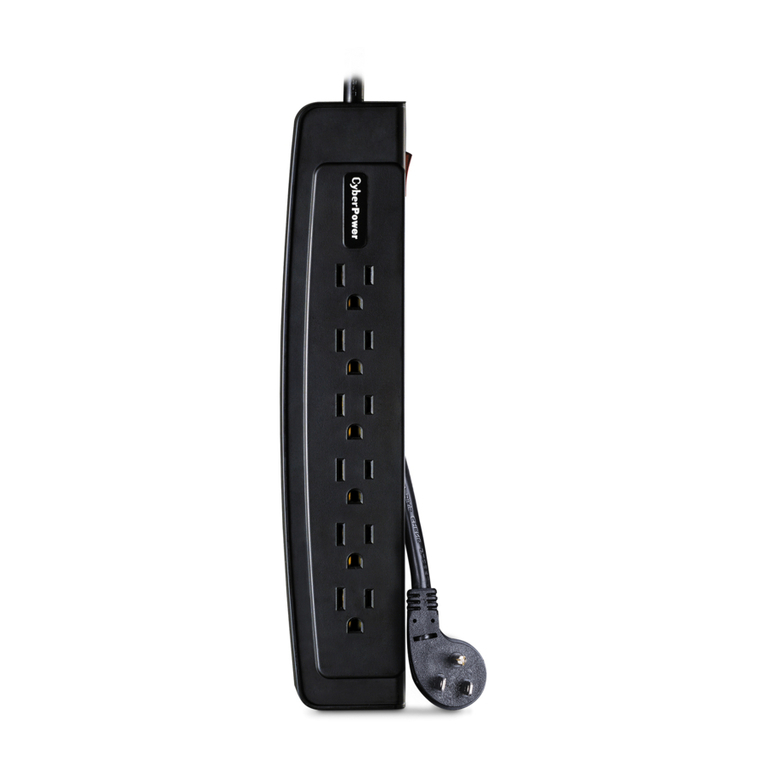
CyberPower
CyberPower CSP604T user manual
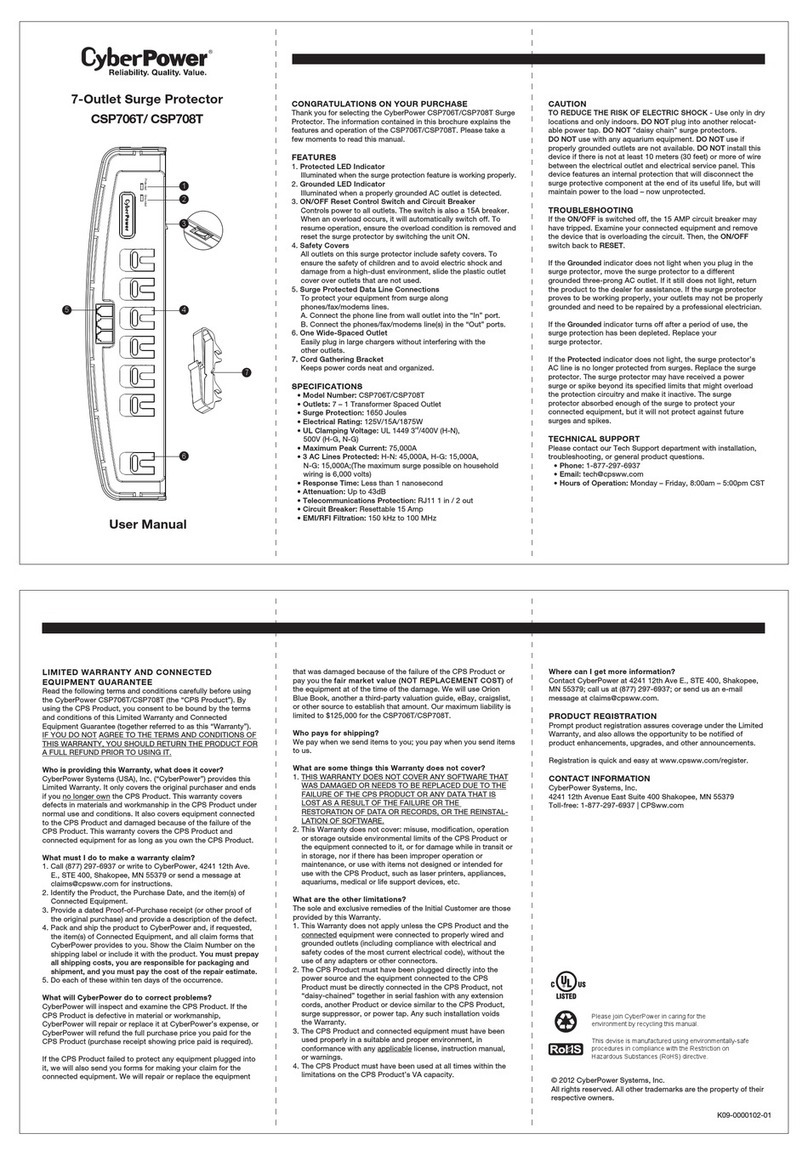
CyberPower
CyberPower CSP706T user manual

Mitsubishi Electric
Mitsubishi Electric LITOL LTM-125RF manual
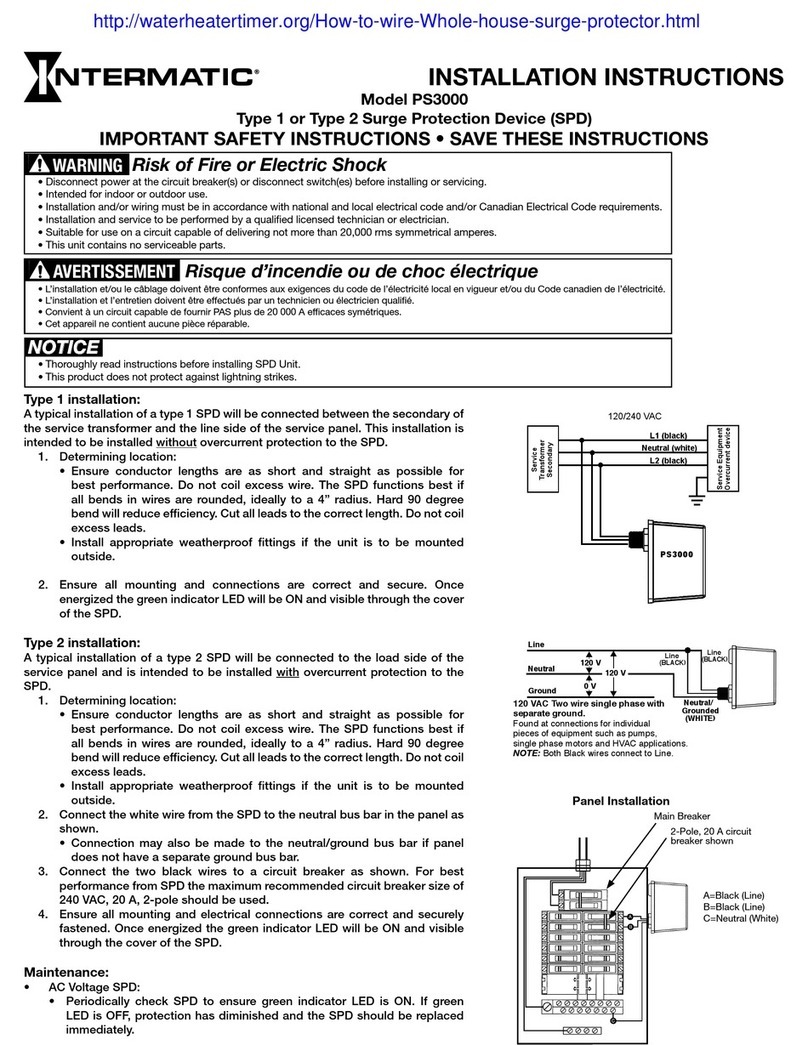
Intermatic
Intermatic PS3000 installation instructions
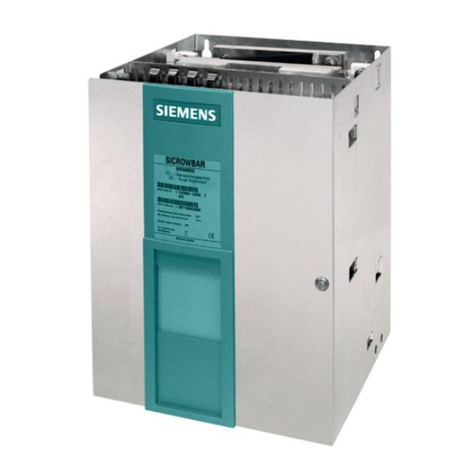
Siemens
Siemens SICROWBAR 7VV3003 operating instructions
